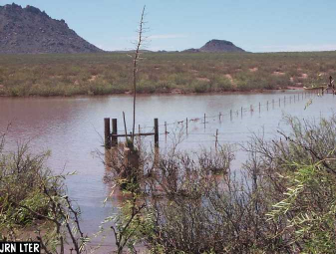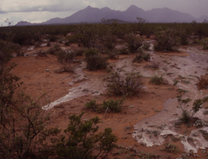Though many research projects at the Jornada Basin LTER begin with observations at the organism or community level, we conduct research into hydrological, aeolian, geological, and biogeochemical processes as well. Combining insights about biotic and abiotic processes helps us scale our findings to the landscape, regional, or even global scale.
Research Highlights


Playa Wetlands as Hot Spots of Desert Nutrient Storage and ANPP
Hydrological studies at the Jornada have quantified sediment transport and runoff at scales ranging from plots and small catchments to large watershed complexes (Templeton et al. 2014, Mckenna and Sala 2018). Surface hydrological transport is especially important for explaining nonlinear vegetation dynamics on downslope, low-lying positions. These hydrologically-subsidized areas are often the most productive and C-rich locations in desert landscapes (Peters et al. 2012, Mckenna and Sala 2016). Their water budget is dependent on levels of runoff which depends on vegetation patches, soil characteristics, and topography (Vivoni 2012). Our work shows that playas (lowest parts of desert watersheds with no hydrological outlet) account for a small fraction of landscape area, yet accumulate C and nutrients at high rates controlled primarily by geomorphic variables (slope, watershed surface area), and weakly related to biotic factors such as plant cover (Mckenna and Sala 2016).
PI: Osvaldo Sala, Enrique Vivoni